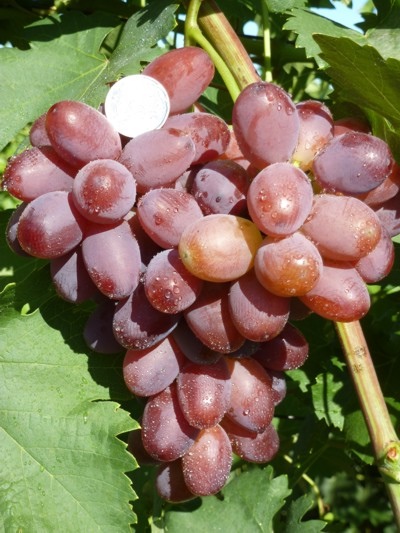
- Authors: Gusev Sergey Eduardovich
- Appointment: dining room
- Berry color: dark pink
- Taste: harmonious, varietal
- Ripening period: early middle
- Ripening period, days: 110-115
- Frost resistance, ° C: -23
- Bunch weight, g: 800-1200
- Flower type: bisexual
- Peeling: No
The Gusar grape stands out favorably among many other varieties. It's an attractive dining culture. Many gardeners will be very interested in exactly how to grow it, and what it is.
Breeding history
The development of the variety was carried out by S.E.Gusev (in whose honor, most likely, the name was given). The initial varieties, along with Pretty Woman, were made by the Talisman. The breeding work was carried out personally, no outside help was needed. The hybrid immediately established itself in the commercial sector.
Description
Ripening period
The grapes are classified as early-medium ripening varieties. Usually, you can harvest the fruits in the last summer decade. Under favorable conditions, the culture ripens a little earlier. Much also depends on the cultivation technique.
Bunches
They reach impressive sizes. They are similar in shape to a regular or extended cone. The density of the brushes is moderate. Their weight can vary from 800 g to 1.2 kg; the attractive feature is the zero risk of peas. Some clusters have a wing.
Berries
The Gusar grape belongs to table crops. The skin of the fruit is pink. It would be more accurate to say that it still has a dark tint. The peel is not too thick, so there is no need to talk about the strength of the crop.
Other parameters:
shape - an oval elongated in length;
size up to 5 cm (these are large fruits);
ripe weight 12-14 g.
Taste
The flesh of the Hussar is fleshy. Tasters also note its undeniable juiciness. According to reviews, the taste sensations are rather harmonious. Nobility and sophistication are found at the level of the best competing varieties. Sugar content - up to 220 g per 1 dm3.
Yield
The culture belongs to a strong-growing group and does not experience developmental problems. One bunch can account for up to 1000 g of the crop. There are no exact figures on fertility per bush in the sources. This is due to the short time of growing the hybrid and the lack of experience; with luck, 4 kilogram brushes are sometimes grown on 1 bush, but conclusions are still premature.


Growing features
Landing
Landing requirements have not yet been developed and defined. The berries will ripen in 110-115 days. The preliminary approach to farming is the same as for other early-medium varieties.

Pollination
The flowers of the culture are bisexual. Additional pollination plantings and neighborhoods are not required. The measures to attract the winged are traditional.
Pruning
Exact pruning figures have not been published.The plant is sprawling, and it often has to be reduced in width than vertically. The overgrowth is relatively weak, and this will have to be done infrequently, possibly irregularly. It is necessary to be guided by the state of a particular bush.



Frost resistance and the need for shelter
Protection against cold due to the thin skin is especially important for this variety. Heat protection structures are required to be used even on the Black Sea shores, not to mention the more northern regions. Some experts believe that the winter hardiness of Gusar is higher than that of similar crops. But this topic requires a long practical study. Exploring a non-sheltered culture in warm areas also has the potential to present a number of surprises.

Diseases and pests
Resistance to major grape ailments is high. It is estimated at 2.5-3 points. Resistance to fungal infections is not fully understood. Even the most seasoned agronomists recommend taking maximum precautions. No particular problems with pests have yet been found.

If a grape is exposed to any disease or insect, this always affects its appearance.
Storage
It is problematic to preserve thin berries for a long time. Their main culinary use is fresh consumption. The transportability is quite high. The fruits are firmly connected to the stalks. With short storage and moderately long-distance transportation, they will not crumble.











































































